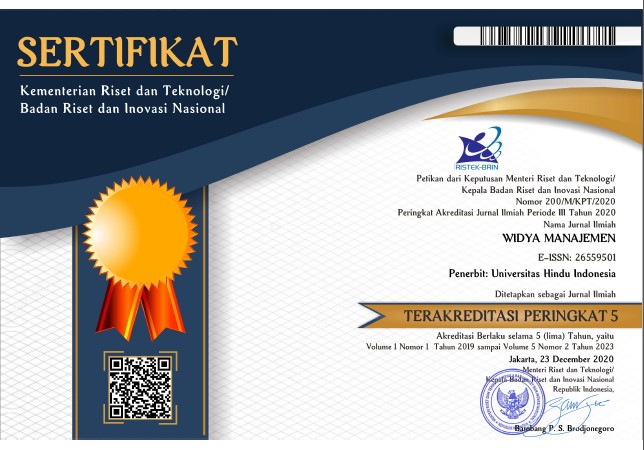Pengaruh Perceived Ease of Use, Perceived Usefulness, dan User Satisfaction terhadap Continuance Intention dalam Bertransaksi dengan Dompet Digital Shopeepay
Abstract
This research aims to determine the influence of perceived ease of use, perceived usefulness, and user satisfaction, on continuance intention in transactions with the shopeepay digital wallet among generation Z in kebomas district. The type of research used is quantitative. The data used in this research is primary data obtained from respondents. This data collection technique is carried out by distributing questionnaires. Questionnaires were distributed offline and online. The population used in this research is generation Z men or women from kebomas district ranging from ages 16 to 23 years who have used the shopeepay digital wallet payment tool when making transactions. The sample used in this research was 110 respondents. The research results show that the perceived ease of use variable has no effect on continuance intention in transactions with the shopeepay digital wallet among generation Z in kebomas district. Meanwhile, the perceived usefulness and user satisfaction variables influence continuance intention in transactions with the shopeepay digital wallet among generation Z in kebomas district.
References
Akbar, D. I., & Yuniarinto, A. (2022). Pengaruh Persepsi Kemudahan Terhadap Niat Berkelanjutan di Mediasi oleh Kepercayaan. Jurnal Manajemen Pemasaran dan Perilaku Konsumen, 1(4), 487-496.
Alalwan, A. A., Dwivedi, Y. K., Rana, N. P., & Williams, M. D. (2016). Consumer adoption of mobile banking in Jordan: Examining the role of usefulness, ease of use, perceived risk and self-efficacy. Journal of Enterprise Information Management. 29(1), 118-139.
Anggraeni, R. (2015). Pengaruh Persepsi Kemudahan Penggunaan dan Persepsi Kegunaan Terhadap Niat Untuk Menggunakan dan Penggunaan Aktual Layanan Jejaring Sosial Berbasis Lokasi (Studi pada Mahasiswa Fakultas Ekonomi dan Bisnis Universitas Brawijaya Malang). Ekonomi Bisnis, 20(1), 45-52.
Bahrudin, M., & Zuhro, S. (2016). Pengaruh kepercayaan dan kepuasan pelanggan terhadap loyalitas pelanggan. BISNIS: Jurnal Bisnis dan Manajemen Islam, 3(1), 1-17.
Cheng, Y. M. (2014). Exploring the intention to use mobile learning: the moderating role of personal innovativeness. Journal of Systems and Information Technology. 16(1), 40-61.
Cudjoe, A. G., Anim, P. A., & Nyanyofio, J. G. N. T. (2015). Service quality and customer satisfaction in the Ghanaian banking industry (A case of Ghana commercial bank). European Journal of Business and Management, 7(3), 123-140.
Damanik, M. A. A., Fauzi, A., & Situmorang, S. H. (2022). Pengaruh Perceived Usefulness, Perceived Enjoyment dan Kepercayaan Terhadap Continuance Intention Melalui Kepuasan Pada Generasi Millenial Pengguna E-Wallet di Kota Medan. Ekonomi, Keuangan, Investasi Dan Syariah (EKUITAS), 3(4), 827-834.
Davis, Gordon B. (2016). Kerangka Dasar Sistem Informasi Manajemen. Palembang: Maxikom.
Ghozali, I. (2016). Aplikasi Analisis Multivariate dengan program SPSS, Badan. Penerbit Universitas Diponegoro, Semarang.
Hartono Jogiyanto. (2017). Sistem Informasi Manajemen (Edisi 2). Universitas Terbuka.
Hendriyawan, N. N., & Mayangsari, S. (2022). Pengaruh Persepsi Kebermanfaatan, Kemudahan, dan Risiko Terhadap Minat Penggunaan Layanan Pembayaran Digitral Pada Mahasiswa Akuntansi. Jurnal Ekonomi Trisakti, 2(2), 611-676.
Indarsin, T., & Ali, H. (2017). Attitude toward Using m-commerce: The analysis of perceived usefulness perceived ease of use, and perceived trust: Case study in Ikens Wholesale Trade, Jakarta–Indonesia. Saudi Journal of Business and Management Studies, 2(11), 995-1007.
Karnadi, Alif. (2022). Dompet Digital Jadi Metode Pembayaran Favorit di E-Commerce.
https://dataindonesia.id/digital/detail/dompet-digital-jadi-metode-pembayaran-favorit-di-ecommerce. Diakses pada 15 Oktober 2022.
Kordina, L., Putra, W. H. N., & Herlambang, A. D. (2019). Evaluasi keadaan continuance intention to use dan citizen support pada implementasi layanan website Pusat Pelayanan Pengaduan Masyarakat (P3M) Kabupaten Sidoarjo. Jurnal Pengembangan Teknologi Informasi Dan Ilmu Komputer, 3(5), 4951-4960.
Lestari, D. M., Chandra, Y. E. N., Sofa, N., & Firdaus, R. Z. (2022, December). Pengaruh Perceived Usefulness dan Perceived Risk Terhadap Continuance Intention Dalam Penggunaan Aplikasi DANA di Jakarta. In Seminar Nasional Riset Terapan (Vol. 11, No. 01, pp. 401-409).
Loanata, T., & Tileng, K. G. (2016). Pengaruh trust dan perceived risk pada intention to use menggunakan technology acceptance model (Studi kasus pada situs e-commerce traveloka). JUISI (Jurnal Informatika dan Sistem Informasi), 2(1), 64-73.
Mahira, M., Hadi, P., & Nastiti, H. (2021). Pengaruh Kualitas Produk Dan Kualitas Pelayanan Terhadap Kepuasan Pelanggan Indihome. Konferensi Riset Nasional Ekonomi Manajemen dan Akuntansi, 2(1), 1267-1283.
Makronesia, Redaksi. (2020). Penggunaan E-wallet ShopeePay Ungguli Semua Kompetitornya.https://www.makronesia.id/penggunaan-e-wallet-shopeepay-ungguli-semua-kompetitornya/. Diakses Pada 17 Oktober 2022.
Naufaldi, I., & Tjokrosaputro, M. (2020). Pengaruh Perceived Ease Of Use, Perceived Usefulness, dan Trust terhadap Intention To Use. Jurnal Manajerial Dan Kewirausahaan, 2(3), 715-722.
Rifda, Arum. (2022). Karakteristik Generasi Z dan Tahun Berapa Generasi Z. https://www.gramedia.com/best-seller/gen-z/. Diakses Pada 17 Oktober 2022.
Sari, Y. R., & Nurmiati, E. (2021). Analisis Kepuasan Pengguna Google Classroom Menggunakan Pieces Framework (Studi Kasus: Program Studi Sistem Informasi Uin Jakarta). InfoTekJar: Jurnal Nasional Informatika dan Teknologi Jaringan, 5(2), 308-313.
Sasongko, S. R. (2021). Faktor-Faktor Kepuasan Pelanggan Dan Loyalitas Pelanggan (Literature Review Manajemen Pemasaran). Jurnal Ilmu Manajemen Terapan, 3(1), 104-114.
Slameto, B. (2015). Belajar dan Faktor-Faktor yang Mempengaruhinya. Rineka cipta.
Sriekaningsih, Ana. (2020). QRIS dan Era Baru Transaksi Pembayaran 4.0. Penerbit Andi.
Sugiyono, M. (2019). Penelitian dan Pengembangan Research and development. Bandung: Alfabeta.
Suharsimi, A. (2013). Prosedur penelitian suatu pendekatan praktik. Jakarta: Rineka Cipta.
Tjiptono Fandy. (2015). Strategi Pemasaran (Edisi 4). Penerbit Andi.
Reproduction Policy
Every author submitting articles to Widya Manajemen must make a statement that the manuscript is free from plagiarism and is not being considered and published in other journals.
Articles that have been published are copyrighted by the Program Studi Manajemen FEBP UNHI. For educational purposes, the contents of the article may be duplicated or reproduced as long as the source of the article is mentioned. Written requests must be submitted to the editor to obtain permission to republish the contents of the article for purposes other than educational purposes.
-----------------------------------------------------------------------------------------------------
Kebijakan Reproduksi
Setiap penulis yang menyerahkan artikel ke Widya Manajemen harus membuat surat pernyataan bahwa naskahnya bebas dari plagiarisme dan tidak sedang dipertimbangkan dan dimuat dalam jurnal lain.
Artikel yang telah dipublikasi menjadi hak cipta Program Studi Manajemen FEBP UNHI. Untuk tujuan edukatif, isi dari artikel dapat digandakan atau direpublikasi selama menyebutkan sumber dari artikel tersebut. Permintaan tertulis harus diajukan kepada editor untuk memperoleh ijin merepublikasi isi dari artikel untuk tujuan lainnya selain tujuan edukatif.






.jpg)









